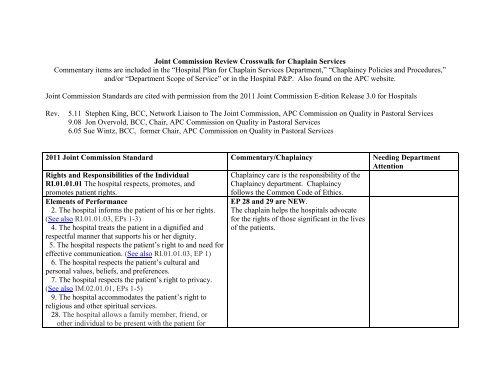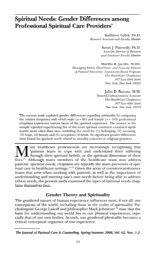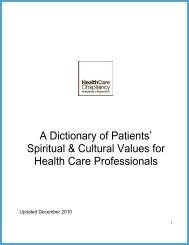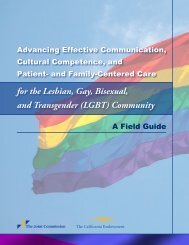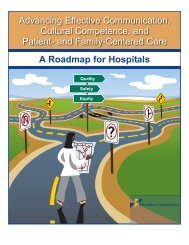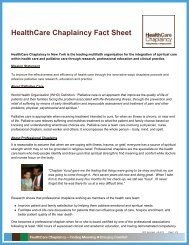Joint Commission Review Crosswalk for Chaplain Services
Joint Commission Review Crosswalk for Chaplain Services
Joint Commission Review Crosswalk for Chaplain Services
You also want an ePaper? Increase the reach of your titles
YUMPU automatically turns print PDFs into web optimized ePapers that Google loves.
<strong>Joint</strong> <strong>Commission</strong> <strong>Review</strong> <strong>Crosswalk</strong> <strong>for</strong> <strong>Chaplain</strong> <strong>Services</strong>Commentary items are included in the ―Hospital Plan <strong>for</strong> <strong>Chaplain</strong> <strong>Services</strong> Department,‖ ―<strong>Chaplain</strong>cy Policies and Procedures,‖and/or ―Department Scope of Service‖ or in the Hospital P&P. Also found on the APC website.<strong>Joint</strong> <strong>Commission</strong> Standards are cited with permission from the 2011 <strong>Joint</strong> <strong>Commission</strong> E-dition Release 3.0 <strong>for</strong> HospitalsRev.5.11 Stephen King, BCC, Network Liaison to The <strong>Joint</strong> <strong>Commission</strong>, APC <strong>Commission</strong> on Quality in Pastoral <strong>Services</strong>9.08 Jon Overvold, BCC, Chair, APC <strong>Commission</strong> on Quality in Pastoral <strong>Services</strong>6.05 Sue Wintz, BCC, <strong>for</strong>mer Chair, APC <strong>Commission</strong> on Quality in Pastoral <strong>Services</strong>2011 <strong>Joint</strong> <strong>Commission</strong> Standard Commentary/<strong>Chaplain</strong>cy Needing DepartmentAttentionRights and Responsibilities of the IndividualRI.01.01.01 The hospital respects, promotes, andpromotes patient rights.<strong>Chaplain</strong>cy care is the responsibility of the<strong>Chaplain</strong>cy department. <strong>Chaplain</strong>cyfollows the Common Code of Ethics.Elements of Per<strong>for</strong>mance2. The hospital in<strong>for</strong>ms the patient of his or her rights.(See also RI.01.01.03, EPs 1-3)4. The hospital treats the patient in a dignified andrespectful manner that supports his or her dignity.5. The hospital respects the patient’s right to and need <strong>for</strong>effective communication. (See also RI.01.01.03, EP 1)6. The hospital respects the patient’s cultural andpersonal values, beliefs, and preferences.7. The hospital respects the patient’s right to privacy.(See also IM.02.01.01, EPs 1-5)9. The hospital accommodates the patient’s right toreligious and other spiritual services.28. The hospital allows a family member, friend, orother individual to be present with the patient <strong>for</strong>EP 28 and 29 are NEW.The chaplain helps the hospitals advocate<strong>for</strong> the rights of those significant in the livesof the patients.
emotional support during the course of stay.Note 1: The hospital allows <strong>for</strong> the presence of asupport individual of the patient’s choice, unless theindividual’s presence infringes on others' rights,safety, or is medically or therapeuticallycontraindicated. The individual may or may not be thepatient's surrogate decision-maker or legallyauthorized representative. (For more in<strong>for</strong>mation onsurrogate or family involvement in patient care,treatment, and services, refer to RI.01.02.01, EPs 6-8.)Note 2: [Effective July 1, 2011, this will be part of theaccreditation survey.]29. The hospital prohibits discrimination based on age,race, ethnicity, religion, culture, language, physical ormental disability, socioeconomic status, sex, sexualorientation, and gender identity or expression.Note: [Effective July 1, 2011, this will be part of theaccreditation survey.]RI. 01.01. 03 The hospital respects the patient’s right toreceive in<strong>for</strong>mation in a manner he or she understandsRI. 01.02.01 The hospital respects the patient’s right toparticipate in decisions about his or her care, treatment,and servicesRI. 01.03.05 The hospital respects the patient’s right toparticipate in decisions about his or her care, treatment,and services.Elements of Per<strong>for</strong>mance1. The hospital reviews all research protocols andweighs the risks and benefits to the patientparticipating in the research.<strong>Chaplain</strong>s provide culturally sensitive, ageappropriate, language specific, andspiritually/religiously appropriate care<strong>Chaplain</strong>s participate in patient/familycentered care, palliative care, and ethicscommitteeBoth IRB participation and IRB approval<strong>for</strong> research in which <strong>Chaplain</strong>s areinvestigators or staffIn conducting research, <strong>Chaplain</strong>s followall research ethics and regulations in orderto protect the patient2
2. To help the patient determine whether or not toparticipate in research, investigation, or clinicaltrials, the hospital provides the patient with all of thefollowing in<strong>for</strong>mation:- An explanation of the purpose of the research- The expected duration of the patient’s participation- A clear description of the procedures to befollowed- A statement of the potential benefits, risks,discom<strong>for</strong>ts, and side effects- Alternative care, treatment, and services availableto the patient that might prove advantageous to thepatient3. To help the patient determine whether or not toparticipate in research, investigation, or clinicaltrials, the hospital provides the patient with all of thefollowing in<strong>for</strong>mation:- An explanation of the purpose of the research- The expected duration of the patient’s participation- A clear description of the procedures to befollowed- A statement of the potential benefits, risks,discom<strong>for</strong>ts, and side effects- Alternative care, treatment, and services availableto the patient that might prove advantageous to thepatient4. The hospital documents the following in the researchconsent <strong>for</strong>m: That the patient received in<strong>for</strong>mationto help determine whether or not to participate in theresearch, investigation, or clinical trials.5. The hospital documents the following in the research3
consent <strong>for</strong>m: That the patient was in<strong>for</strong>med thatrefusing to participate in research, investigation, orclinical trials, or discontinuing participation at anytime will not jeopardize his or her access to care,treatment, and services unrelated to the research.6. The hospital documents the following in the researchconsent <strong>for</strong>m: The name of the person who providedthe in<strong>for</strong>mation and the date the <strong>for</strong>m was signed.7. The research consent <strong>for</strong>m describes the patient'sright to privacy, confidentiality, and safety.RI. 01.05.01 The hospital addresses patient decisionsabout care, treatment, and services received at the end oflifeElements of Per<strong>for</strong>mance10. Upon request, the hospital refers the patient toresources <strong>for</strong> assistance in <strong>for</strong>mulating advance directives.RI. 01.06.03 The patient has the right to be free fromneglect; exploitation; and verbal, mental, physical, andsexual abuse.PC.01.02.01 The hospital assesses and reassesses itspatients.<strong>Chaplain</strong>s explore the values of the patient,including advance directives, and bothencourage the patient to communicate to thehealth care team and communicatethemselves to the health care team asappropriate.<strong>Chaplain</strong>s are one of the resources <strong>for</strong>assisting patients in <strong>for</strong>mulating advancedirectives consistent with the patient’svalues and goals<strong>Chaplain</strong>s are respectful, maintainappropriate boundaries, and honor theCommon Code of EthicsScreening, assessment, and reassessment areincluded in the comprehensive plan <strong>for</strong>chaplaincy care.Elements of Per<strong>for</strong>mance:1. The hospital defines, in writing, the scope andcontent of screening, assessment, and reassessment4
in<strong>for</strong>mation it collects2. The hospital defines, in writing, criteria thatidentify when additional, specialized, or more indepthassessments are per<strong>for</strong>med.4. Based on the patient's condition, in<strong>for</strong>mationgathered in the initial assessment includes thefollowing:- Physical, psychological, and social assessment- Nutrition and hydration status- Functional status- For patients who are receiving end-of-life care,the social, spiritual, and cultural variables thatinfluence the patient’s and family members’perception of griefPC. 01.02.03 The hospital assesses and reassesses thepatient and his or her condition according to defined timeframesPC. 01.02.05 Qualified staff or independent practitionersassess or reassess the patientPC.01.02.07 The hospital assesses and manages thepatient’s pain.Time frame <strong>for</strong> initial assessments (andideally reassessment) included in<strong>Chaplain</strong>cy scope of service documentsAll practitioners can screen. Preferably aBCC (or supervisee) assesses or reassesses<strong>Chaplain</strong>s may have a role in addressingpainElements of Per<strong>for</strong>mance:1. The hospital conducts a comprehensive painassessment that is consistent with its scope of care,treatment, and services and the patient’s condition.(See also PC.01.02.01, EP 2; RI.01.01.01, EP 8)2. The hospital uses methods to assess pain that areconsistent with the patient’s age, condition, andability to understand.3. The hospital reassesses and responds to the patient’s5
pain, based on its reassessment criteria.4. The hospital either treats the patient’s pain or refersthe patient <strong>for</strong> treatment.PC.01.02.11 The hospital assesses the needs of patientswho receive psychosocial services <strong>for</strong> the treatment ofalcoholism or other substance use disorders.Elements of Per<strong>for</strong>mance5. Based on the patient’s age and needs, the assessment<strong>for</strong> patients receiving psychosocial services <strong>for</strong> thetreatment of alcoholism or other substance usedisorders includes the following:- The patient’s religion and spiritual beliefs,values, and preferences- Living situation- Leisure and recreation activities- Military service history- Peer-group- Social factors- Ethnic and cultural factors- Financial status- Vocational or educational background- Legal history- Communication skillsPC. 01.02.13 The hospital assesses the needs of patientswho receive treatment <strong>for</strong> emotional and behavioraldisorders.Alcoholism or other substance abuse addedto triggers <strong>for</strong> assessment in Scope ofPractice and Plan of Care.Treatment of emotional or behavioraldisorders added to triggers <strong>for</strong> assessment inScope of Practice and Plan of Care.Elements of Per<strong>for</strong>mance3. Based on the patient’s age and needs, the assessment<strong>for</strong> patients receiving psychosocial services <strong>for</strong> the6
treatment of alcoholism or other substance use disordersincludes the following:- The patient’s religion and spiritual beliefs, values,and preferences- Living situation- Leisure and recreation activities- Military service history- Peer-group- Social factors- Ethnic and cultural factors- Financial status- Vocational or educational background- Legal history- Communication skillsPC. 01.03.01 The hospital plans the patient’s care.Elements of Per<strong>for</strong>mance1. The hospital plans the patient’s care, treatment,and services based on needs identified by thepatient’s assessment, reassessment, and results ofdiagnostic testing. (See also RC.02.01.01, EP 2)5. The written plan of care is based on the patient’sgoals and the time frames, settings, and servicesrequired to meet those goals.22. Based on the goals established in the patient’s planof care, staff evaluate the patient’s progress.23. The hospital revises plans and goals <strong>for</strong> care,treatment, and services based on the patient’sneeds. (See also RC.02.01.01, EP 2)PC. 02.01.05 The hospital provides interdisciplinary,collaborative care, treatment, and services.Included in <strong>Chaplain</strong>cy’s Scope of Service<strong>Chaplain</strong>cy care is enhanced when providedin an interdisciplinary approach. Included7
Elements of Per<strong>for</strong>mance:1. Care, treatment, and services are provided to thepatient in an interdisciplinary, collaborative manner.PC. 02.01.21 The hospital effectively communicates withpatients when providing care, treatment, and services.Note: This standard will not effect the accreditationdecision at this time.in <strong>Chaplain</strong>cy’s Scope of ServiceNEWRationale:This standard emphasizes the importance of effectivecommunication between patients and their providers ofcare, treatment, and services. Effective patient-providercommunication is necessary <strong>for</strong> patient safety. Researchshows that patients with communication problems are atan increased risk of experiencing preventable adverseevents, * and that patients with limited Englishproficiency are more likely to experience adverse eventsthan English speaking patients. ** ***Identifying the patient’s oral and written communicationneeds is an essential step in determining how to facilitatethe exchange of in<strong>for</strong>mation with the patient during thecare process. Patients may have hearing or visual needs,speak or read a language other than English, experiencedifficulty understanding health in<strong>for</strong>mation, or be unableto speak due to their medical condition or treatment.Additionally, some communication needs may changeduring the course of care. Once the patient’s8
communication needs are identified, the hospital candetermine the best way to promote two-waycommunication between the patient and his or herproviders in a manner that meets the patient’s needs. Thisstandard complements RI.01.01.01, EP 5 (patient right toand need <strong>for</strong> effective communication); RI.01.01.03, EP 2(provision of language interpreting and translationservices); and RI.01.01.03, EP 3 (meeting needs ofpatients with vision, speech, hearing, or cognitiveimpairments).Footnote *: Bartlett G, Blais R, Tamblyn R, Clermont RJ,MacGibbon B: Impact of patient communication problemson the risk of preventable adverse events in acute caresettings. CMAJ 178(12):1555–1562, Jun. 3, 2008.Footnote **: Divi C, Koss RG, Schmaltz SP, Loeb JM:Language proficiency and adverse events in U.S.hospitals: A pilot study. Int J Qual Health Care 19(2):60–67, Apr. 2007.Footnote ***: Cohen AL, Rivara F, Marcuse EK,McPhillips H, Davis R: Are language barriers associatedwith serious medical events in hospitalized pediatricpatients? Pediatrics 116(3):575–579, Sep. 2005.Elements of Per<strong>for</strong>mance:1. The hospital identifies the patient's oral and writtencommunication needs, including the patient'spreferred language <strong>for</strong> discussing health care. (Seealso RC.02.01.01, EP 1)Note 1: Examples of communication needs includethe need <strong>for</strong> personal devices such as hearing aids orglasses, language interpreters, communication9
oards, and translated or plain language materials.Note 2: This element of per<strong>for</strong>mance will not affectthe accreditation decision at this time.2. The hospital communicates with the patient duringthe provision of care, treatment, and services in amanner that meets the patient's oral and writtencommunication needs. (See also RI.01.01.03, EPs 1-3)Note 1: This element of per<strong>for</strong>mance will not affectthe accreditation decision at this time.PC. 02.02.03 The hospital makes food and nutritionproducts available to its patients.Elements of Per<strong>for</strong>mance:9. When possible, the hospital accommodates thepatient’s cultural, religious, or ethnic food and nutritionpreferences, unless contraindicated.PC.02.02.13 The patient’s com<strong>for</strong>t and dignity receivepriority during end-of-life care.Elements of Per<strong>for</strong>mance1. To the extent possible, the hospital provides care andservices that accommodate the patient's and his orher family’s com<strong>for</strong>t, dignity, psychosocial,emotional, and spiritual end-of-life needs.2. The hospital provides staff with education about theunique needs of dying patients and their families.PC.02.03.01 The hospital provides patient education andtraining based on each patient’s needs and abilities.Elements of Per<strong>for</strong>mance:Included in <strong>Chaplain</strong>cy’s Scope of Serviceas a trigger <strong>for</strong> assessmentIncluded in <strong>Chaplain</strong>cy’s Scope of Service.Additional trigger <strong>for</strong> assessment<strong>Chaplain</strong>s have an educational role in healthcare. Trigger <strong>for</strong> assessment. Included in<strong>Chaplain</strong>cy’s Scope of Service.10
1. The hospital per<strong>for</strong>ms a learning needs assessment<strong>for</strong> each patient, which includes the patient’s culturaland religious beliefs, emotional barriers, desire andmotivation to learn, physical or cognitive limitations,and barriers to communication.2. The hospital provides education and training to thepatient based on his or her assessed needs.5. The hospital coordinates the patient education andtraining provided by all disciplines involved in thepatient’s care, treatment, and services.DISCHARGE OR TRANSFERPC.04.01.01 The hospital has a process that addresses thepatient’s need <strong>for</strong> continuing care, treatment, and servicesafter discharge or transfer.HOSPITAL PERFORMANCE IMPROVEMENTPI.01.01.01 The hospital collects data to monitor itsper<strong>for</strong>mance.PI.02.01.01 The hospital compiles and analyzes data.Included in <strong>Chaplain</strong>cy’s Scope of Service.<strong>Chaplain</strong>cy provides education and/or aplan <strong>for</strong> ongoing spiritual/religious carepost-transfer or discharge as neededIncluded in <strong>Chaplain</strong>cy’s Scope ofService—continuous quality improvement(CQI)Included in <strong>Chaplain</strong>cy’s Plan <strong>for</strong> CQI.Elements of Per<strong>for</strong>mance1. The hospital compiles data in usable <strong>for</strong>mats.2. The hospital identifies the frequency <strong>for</strong> dataanalysis.3. The hospital uses statistical tools and techniques toanalyze and display data.4. The hospital analyzes and compares internal dataover time to identify levels of per<strong>for</strong>mance, patterns,trends, and variations.12. When the hospital identifies undesirable patterns,trends, or variations in its per<strong>for</strong>mance related to thesafety or quality of care (<strong>for</strong> example, as identified11
in the analysis of data or a single undesirable event),it includes the adequacy of staffing, including nursestaffing, in its analysis of possible causes.Note 1: Adequacy of staffing includes the number,skill mix, and competency of all staff. In theiranalysis, hospitals may also wish to examine issuessuch as processes related to work flow; competencyassessment; credentialing; supervision of staff; andorientation, training, and education.PI.03.01.01 The hospital improves per<strong>for</strong>mance.Elements of Per<strong>for</strong>mance:1. Leaders prioritize the identified improvementopportunities. (See also PI.02.01.01, EP 8;MS.05.01.01, EPs 1-11)2. The hospital takes action on improvement priorities.(See also MS.05.01.01, EPs 1-11)3. The hospital evaluates actions to confirm that theyresulted in improvements. (See also MS.05.01.01,EPs 1-11)4. The hospital takes action when it does not achieve orsustain planned improvements. (See alsoMS.05.01.01, EPs 1-11)PI 04.01.01 The hospital uses data from clinical/servicescreening indicators and human resource screeningindicators to assess and continuously improve staffingeffectiveness.LEADERSHIPLD.03.02.01 The hospital uses data and in<strong>for</strong>mation toguide decisions and to understand variation in theper<strong>for</strong>mance of processes supporting safety and quality.Included in <strong>Chaplain</strong>cy’s Plan <strong>for</strong> CQI.Included in <strong>Chaplain</strong>cy’s Plan <strong>for</strong> CQI.Included in <strong>Chaplain</strong>cy’s Plan <strong>for</strong> CQI.12
Rationale:Data help hospitals make the right decisions. Whendecisions are supported by data, hospitals are more likelyto move in directions that help them achieve their goals.Successful hospitals measure and analyze theirper<strong>for</strong>mance. When data are analyzed and turned intoin<strong>for</strong>mation, this process helps hospitals see patterns andtrends and understand the reasons <strong>for</strong> their per<strong>for</strong>mance.Many types of data are used to evaluate per<strong>for</strong>mance,including data on outcomes of care, per<strong>for</strong>mance on safetyand quality initiatives, patient satisfaction, processvariation, and staff perceptions.IntroductionA hospital’s culture reflects the beliefs, attitudes, andpriorities of its members, and it influences theeffectiveness of per<strong>for</strong>mance. Although there may be adominant culture, in many larger hospitals diverse culturesexist that may or may not share the same values. In fact,diverse cultures can exist even in smaller hospitals.Hospital per<strong>for</strong>mance can be effective in either case.Successful hospitals will work to develop a culture ofsafety and quality.In a culture of safety and quality, all individuals arefocused on maintaining excellence in per<strong>for</strong>mance. Theyaccept the safety and quality of patient care, treatment,and services as personal responsibilities and work togetherto minimize any harm that might result from unsafe orpoor quality of care, treatment, and services. Leaders13
create this culture by demonstrating their commitment tosafety and quality and by taking actions to achieve thedesired state. In a culture of this kind, one finds teamwork,open discussions of concerns about safety and quality, andthe encouragement of and reward <strong>for</strong> internal and externalreporting of safety and quality issues. The focus ofattention is on the per<strong>for</strong>mance of systems and processesinstead of the individual, although reckless behavior and ablatant disregard <strong>for</strong> safety are not tolerated. Hospitals arecommitted to ongoing learning and have the flexibility toaccommodate changes in technology, science, and theenvironment.Elements of Per<strong>for</strong>mance:5. The hospital uses data and in<strong>for</strong>mation in decisionmaking that supports the safety and quality of care,treatment, and services. (See also NR.02.01.01, EPs 3 and6; PI.02.01.01, EP 8).LD.03.03.01 Leaders use hospital-wide planning toestablish structures and processes that focus on safety andquality.LD.03.06.01 Those who work in the hospital are focusedupon improving safety and quality.LD.04.01.05 The hospital effectively manages itsprograms, services, sites, or departments.Elements of Per<strong>for</strong>mance:1. Leaders of the program, service, site, or departmentoversee operations.2. Programs, services, sites, or departments providingpatient care are directed by one or more qualified<strong>Chaplain</strong>cy participates in hospital CQI<strong>Chaplain</strong>cy participates in hospital CQIResponsibility and Accountability in<strong>Chaplain</strong>cy documentsElements of Per<strong>for</strong>mance:14
professionals or by a qualified licensed independentpractitioner with clinical privileges.3. The hospital defines, in writing, the responsibility ofthose with administrative and clinical direction of itsprograms, services, sites, or departments. (See alsoNR.01.01.01, EP 5)4. Staff are held accountable <strong>for</strong> their responsibilities.5. Leaders provide <strong>for</strong> the coordination of care,treatment, and services among the hospital'sdifferent programs, services, sites, or departments.(See also NR.01.01.01, EP 1)LD.04.01.07 The hospital has policies and procedures thatguide and support patient care, treatment, and services.LD.04.01.11 The hospital makes space and equipmentavailable as needed <strong>for</strong> the provision of care, treatmentand services.Elements of Per<strong>for</strong>mance:2. The arrangement and allocation of space supportssafe, efficient, and effective care, treatment, and services.LD.04.03.07 Patients with comparable needs receive thesame standard of care, treatment, and services throughoutthe hospital.Elements of Per<strong>for</strong>mance:1. Variances in staff, setting, or payment source do notaffect outcomes of care, treatment, and services in anegative way.2. Care, treatment, and services are consistent with thehospital’s mission, vision, and goals.LD. 04.03.09 Care, treatment, and services providedHospital plan includes<strong>Chaplain</strong>cy/chaplaincy care.Equity of care is a standard <strong>for</strong> <strong>Chaplain</strong>cySome <strong>Chaplain</strong>cy services are through15
through contractual agreement are provided safely andeffectively.contractual agreements. Those servicesmust also be safe and effective.Elements of Per<strong>for</strong>mance:1. The hospital describes, in writing, the nature andscope of services provided through contractualagreements.4. Leaders monitor contracted services by establishingexpectations <strong>for</strong> the per<strong>for</strong>mance of the contractedservices.LD.04.04.03 New or modified services or processes arewell-designed.Elements of Per<strong>for</strong>mance:1. The hospital's design of new or modified services orprocesses incorporates the needs of patients, staff,and others.2. The hospital's design of new or modified services orprocesses incorporates the results of per<strong>for</strong>manceimprovement activities.4. The hospital's design of new or modified services orprocesses incorporates evidence-based in<strong>for</strong>mationin the decision-making process.Note: For example, evidence-based in<strong>for</strong>mationcould include practice guidelines, successfulpractices, in<strong>for</strong>mation from current literature, andclinical standards.7. Leaders involve staff and patients in the design ofnew or modified services or processes.LD. 04.04.07 The hospital considers clinical practiceThis might be part of a CQI approach.<strong>Chaplain</strong>s participate in hospital and16
guidelines when designing or improving processes.Rationale:Clinical practice guidelines can improve the quality,utilization, and value of health care services. … Sourcesof clinical practice guidelines include the Agency <strong>for</strong>Healthcare Research and Quality, the National GuidelineClearinghouse, and professional organizations.TRANSPLANT SAFETYTS.01.01.01 The hospital, with the medical staff’sparticipation, develops and implements written policiesand procedures <strong>for</strong> donating and procuring organs andtissues.departmental CQI.<strong>Chaplain</strong> may function as or interact withOrgan Procurement Organization Facilitatoror Designated Family CommunicationsCoordinator.Elements of Per<strong>for</strong>mance:5. Staff education includes training in the use ofdiscretion and sensitivity to the circumstances,beliefs, and desires of the families of potential organ,tissue, or eye donors.6. The hospital develops, in collaboration with thedesignated organ procurement organization, writtenprocedures <strong>for</strong> notifying the family of each potentialdonor about the option to donate or decline to donateorgans, tissues, or eyes.7. The individual designated by the hospital to notifythe family regarding the option to donate or declineto donate organs, tissues, or eyes is an organprocurement representative, an organizationalrepresentative of a tissue or eye bank, or adesignated requestor.Note: A designated requestor is an individual who17
has completed a course offered or approved by theorgan procurement organization. This course isdesigned in conjunction with the tissue and eye bankcommunity to provide a methodology <strong>for</strong>approaching potential donor families and requestingorgan and tissue donation.HUMAN RESOURCESHR.01.02.01 The hospital defines staff qualifications.Elements of Per<strong>for</strong>mance:1. The hospital defines staff qualifications specific totheir job responsibilities. (See also IC.01.01.01, EP 3 andRI.01.01.03, EP 2)HR.01.04.01 The hospital provides orientation to staff.Elements of Per<strong>for</strong>mance:5. The hospital orients staff on the following:Sensitivity to cultural diversity based on their jobduties and responsibilities. Completion of thisorientation is documented.6. The hospital orients staff on the following: Patientrights, including ethical aspects of care, treatment,and services and the process used to address ethicalissues based on their job duties and responsibilities.Completion of this orientation is documented.HR.01.05.03 Staff participate in ongoing education andtraining.HR.01.06.01 Staff are competent to per<strong>for</strong>m theirresponsibilities.Included in Staffing Plan; Definition ofBoard Certified <strong>Chaplain</strong> is included in<strong>Chaplain</strong>cy documents.<strong>Chaplain</strong> is both educator and engages ineducation<strong>Chaplain</strong>s must also continue to learn andgrow.<strong>Chaplain</strong>cy defines and achievescompetencies <strong>for</strong> serviceElements of Per<strong>for</strong>mance:18
1. The hospital defines the competencies it requires ofits staff who provide patient care, treatment, orservices.2. The hospital uses assessment methods to determinethe individual's competence in the skills beingassessed.Note: Methods may include test taking, returndemonstration, or the use of simulation.5. Staff competence is initially assessed anddocumented as part of orientation.6. Staff competence is assessed and documented onceevery three years, or more frequently as required byhospital policy or in accordance with law andregulation.15. The hospital takes action when a staff member’scompetence does not meet expectations.RECORD OF CARE, TREATMETN ANDSERVICESRC.02.02.01 The medical record contains in<strong>for</strong>mation thatreflects the patient’s care, treatment, and services.<strong>Chaplain</strong>s document in the medical recordElements of Per<strong>for</strong>mance: (A summary follows)Documentation and findings of assessments andreassessmentsThe reason(s) <strong>for</strong> admission <strong>for</strong> care, treatment,and servicesThe goals of the treatment and the treatment planProgress notes made by authorized individualsAll reassessments and plan of care revisions, whenindicated19
The response to care, treatment, and servicesprovidedAdvance directivesINFORMATION MANAGEMENTIM.02.02.01 The hospital protects the privacy of healthin<strong>for</strong>mation.Elements of Per<strong>for</strong>mance:4. The hospital discloses health in<strong>for</strong>mation only asauthorized by the patient or as otherwise consistent withlaw and regulation. (See also RI.01.01.01, EP 7)<strong>Chaplain</strong>cy documents are clear aboutprivacy in relationship to sharing healthin<strong>for</strong>mation, including with faith groups,and in terms of opening medical records20


